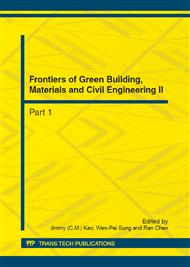p.753
p.757
p.762
p.770
p.776
p.780
p.785
p.791
p.796
Characteristics of Shuiboxia Landslide Triggered by the 2008 Wenchuan Earthquake in China
Abstract:
This paper presents a case study detailing the characteristics and mechanism of Shuiboxia landslide revival induced by the earthquake located in Bailongjiang River, 700 m upstream of the Shuiboxia Dam, in North West of China. After the“5.12”Wenchuan earthquake, landslide revived entirely and downstream zone cracked quite evidently. Based on the regional geology background, detailedly researched the deformation and mechanism of landslide. The research manifested that landslide revival is attributed to cumulative effect of seismic shaking resulting in reducing of strength parameters of the sliding zone, deformation were affected by the landform and evident amplification effect of landslide under the earthquake. Numerical simulation adequately explained the mechanism of landslide revival.
Info:
Periodical:
Pages:
776-779
Citation:
Online since:
August 2012
Authors:
Keywords:
Price:
Сopyright:
© 2012 Trans Tech Publications Ltd. All Rights Reserved
Share:
Citation:


